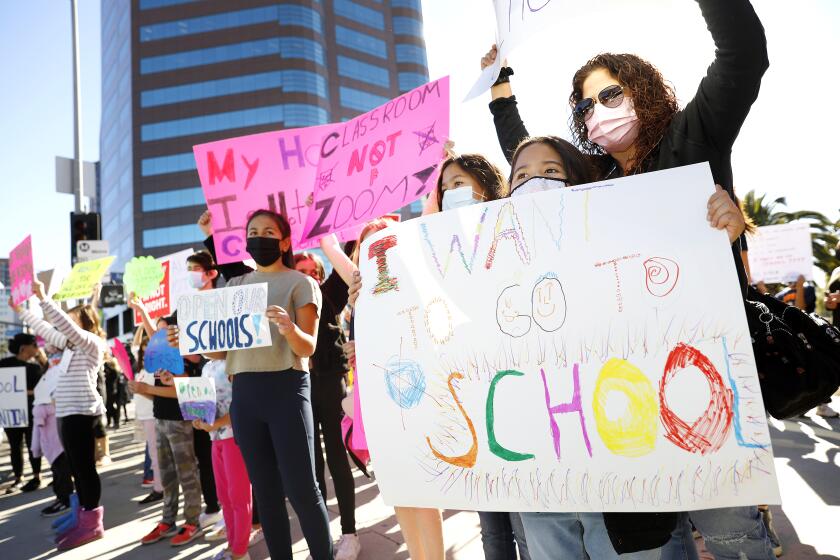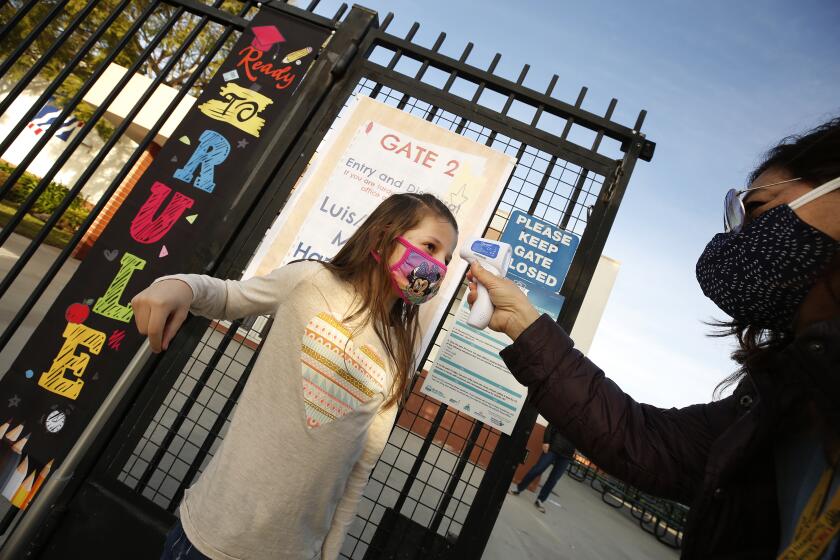Reopening high schools gets ugly, divisive in Bay Area district where rich and poor mix
- Share via
MENLO PARK, Calif. — South of San Francisco, the Sequoia Union High School District serves some of the Bay Area’s wealthiest communities, such as Atherton, Menlo Park and Woodside, as well as some of its neediest, including East Palo Alto, North Fair Oaks and Redwood City.
On Tuesday, the school district learned it had risen into a state tier that would allow high school students, if they chose, to resume on-campus learning. At the urging of many parents, district leaders on Wednesday announced an April reopening plan.
For the record:
7:13 p.m. Feb. 27, 2021A previous version of this story misspelled the name of East Palo Alto Academy teacher Allison Mok as Alison Mock and referred to Sequoia Union school board President Alan Sarver as Adam. It also said Sequoia Union had eight high schools. The district has seven high schools.
That is when things got ugly.
“How many deaths will you accept as collateral for your two months of school? Can you live with that?” Allison Mok, a teacher at East Palo Alto Academy, asked the district’s board of trustees in a contentious Zoom meeting Wednesday.
Reopenings of high schools in the Bay Area provide a window into conflicts sure to play out in Los Angeles and other parts of California as more counties move into less restrictive tiers. Schools in wealthier areas tend to be more willing — and better prepared — than their poorer counterparts to restart in-class instruction, at least in L.A. County, as The Times revealed in an investigation this month.
In the Sequoia Union district, some teachers feel the reopening process has been too rushed and urged students to apply pressure on their parents to stop it.
“Expect a rant the next time u see me,” a Menlo Atherton High School teacher wrote to his junior-level U.S. history class Thursday. “If u don’t want this to be happening, I will highly encourage you to encourage your parents to go full karen on the school and at the school board meeting.”
With parents and children tired of living as Zoombies — and state and federal governments pushing to reopen schools — momentum builds against the go-slow approach of the Los Angeles teachers union and L.A. school district officials.
Low coronavirus case counts and other factors led California to move San Mateo County from the purple tier — the most restrictive — into the red tier this week, allowing for high schools to reopen as long as they follow strict guidelines on distancing, classroom ventilation and reducing class sizes to 25% of capacity.
In a deal negotiated between the district and the Sequoia District Teachers Assn., the students in the district’s seven high schools could choose to return to campus April 5 for a term scheduled to end June 4.
The plan, as described Wednesday and seen in point-by-point slides provided to some students the next day, would involve a hybrid form of instruction in which four small cohorts of students would return to campus two days a week, every two weeks.
The students on campus would receive instruction in a classroom, where their teacher would be simultaneously instructing students at home or other remote locations.
Though negotiating teams from the district and union have agreed to the plan, it still requires ratification from union members. That vote will happen next week.
The plan’s passage is anything but certain, given the response of many teachers this week.
Board President Alan Sarver noted that the district is unusual, with affluent and low-income families in proximity to each other.
“The extremes here are so great and so apparent,” he said. The town of Atherton — which for the last four years has topped Bloomberg’s list as the richest in the country — shares a border with North Fair Oaks, one of the region’s less affluent. And they are in the same district.
As in much of California, each community’s experience with the COVID-19 pandemic has shaped how parents and teachers view school reopenings. In East Palo Alto, where the median household income in 2018 was roughly $64,000, the coronavirus case rate as of Friday was five times higher than in Atherton, where the average annual household income in 2020 was more than $520,000.
Vaccination rates are also different: As of Friday, just 10.16% of East Palo Alto residents have received a shot, compared with 43.98% of those living in Atherton.
A Times survey of over 20 school districts found that those in wealthier, whiter communities were more likely to be moving full steam ahead to reopen elementary schools.
The average age of an Atherton resident skews higher than in East Palo Alto, which could explain some of the discrepancy in vaccination rates, but the historical inequities between the communities underscore the distrust expressed at Wednesday’s meeting.
“It’s another reflection of the deep, systemic racism that exists within our district and that has existed within our district for decades,” said Andy Robinson, a teacher at East Palo Alto Academy.
Parents and students were not among those voicing the most concern Wednesday. Of the 37 public comments made, 16 voiced disapproval of the plan to return — 14 of those were from teachers.
Eva Tang, a teacher at East Palo Alto Academy, said she lost her father to COVID-19.
“But more heartbreaking than my own father’s death are the messages I got from students,” she said, reciting a few: “‘Can I take a break from class? I’ve been crying because my great grandma just died,’ and, ‘My mom’s in the hospital and I got COVID, too, so I know that it’s real.’”
Sarver said he understood the fear and distrust, but “ironically, these are the communities faring the poorest with distance instruction.”
Several surveys, studies and analyses have shown learning gaps and profound differences in outcomes for children during the pandemic, depending on whether they live in affluent or impoverished school districts.
“These are the communities where we have the greatest urgency,” Sarver said.
Others argued the proposed hybrid model would provide substandard instruction for both those in classrooms and those Zooming in remotely.
Edith Salvatore, the president of the teachers union, said that although she understood the desire to have children back on campus for the social experience, the quality of teaching would deteriorate.
“You’re going to have a handful of students in the classroom, sitting at their desks in front of their laptops with their headphones on watching their teacher, who is also sitting at a desk, in front of a laptop with headphones on,” she said. “Emotionally and socially, sure, there are benefits. Pedagogically? It’s no good.”
Many, particularly parents identified with the Reopen SUHSD campaign, praised the decision. They noted that mental health issues have arisen among students unable to socialize or be around their peers, as well as research showing that few outbreaks have been tied to the resumption of in-person learning.
Several public middle and elementary schools in the area have been offering hybrid on-campus learning for students since fall.
“The science is clear that the benefits of reopening schools far outweigh the costs of returning,” said Kari Mueller, a parent in the district and an active member of the Reopen SUHSD campaign. “There has been virtually no communal spread of the disease in the hundreds of school districts that have opened across the country and the world. If done properly, it is safe.”
Others, including the board’s student trustee, Sathvik Nori, agreed.
“It’s not ideal,” said Nori, a senior at Menlo Atherton High School. “But we should think of it as trial period. A time to iron out the kinks, so when school starts this fall, things will be smoother.”
Ronald Sanchez, the 22-year-old teacher who sent the “karen” message to his students, said he regretted his “ill informed and emotionally charged response” and chalked it up to being a first-year teacher.
“I love my students,” he said, adding that later Thursday afternoon, he cried on a Zoom call with his fifth-period class while commemorating the brave and intrepid teachers of earlier eras.
“I thought of all the teachers that came before me,” he said. “Those that were asked to teach during the Cold War, under the threat of nuclear annihilation. The teachers that taught after 9/11. And those that went into classrooms with the threat of mass shootings. I just hope I can serve my students as well during this challenging time.”
More to Read
Sign up for Essential California
The most important California stories and recommendations in your inbox every morning.
You may occasionally receive promotional content from the Los Angeles Times.
















